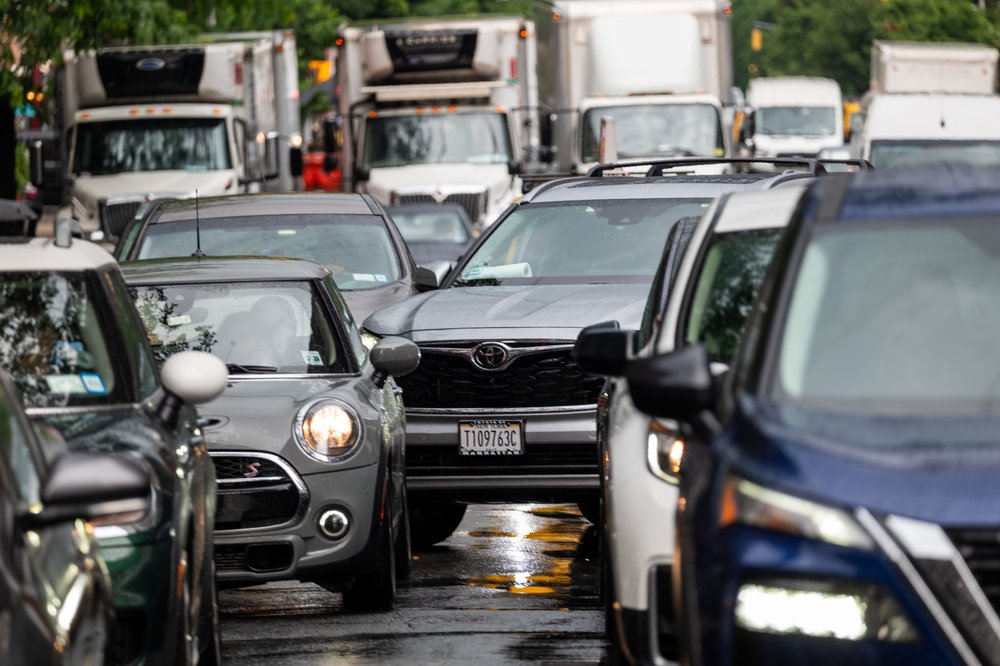Congestion pricing’s white knuckle landing in NYC
Jan. 3, 2025, 11:28 a.m.
The landmark tolling program is slated to launch on Sunday, but its planned arrival is being met with outrage.

This column originally appeared in On The Way, a weekly newsletter covering everything you need to know about NYC-area transportation.
Sign up to get the full version, which includes answers to reader questions, trivia, service changes and more, in your inbox every Thursday.
Congestion pricing is set to finally begin in Manhattan on Sunday after years stuck in political and legal gridlock.
Nearly six years ago, New York state lawmakers approved the landmark tolling program that will charge motorists traveling below 60th Street and use the proceeds to pay for mass transit repairs. Then-Gov. Andrew Cuomo signed the program into law in April 2019 – and it’s faced fierce criticism from both ends of the political spectrum ever since.
New York Republicans lambasted the tolling program shortly after it was approved. During his first term in the White House, Donald Trump’s administration slow-walked the federally-required environmental review for the program. The pandemic caused further delays. Shortly before the tolls were originally to go into effect, Gov. Kathy Hochul imposed a six-month “pause” ahead of the 2024 election. After voters had cast their ballots, Hochul revived the tolling program at a lower base price of $9 — a 40% reduction from the $15 fare the MTA had planned. Meanwhile, Cuomo withdrew his support for congestion pricing, arguing the tolls could endanger the city’s post-pandemic economic recovery.
The program has also narrowly survived a litany of lawsuits. In one of those suits, a New Jersey federal judge this week ordered the Federal Highway Administration to provide more details about the mitigation efforts for communities that will see an increase in traffic — but didn’t halt the program. A last minute hearing is scheduled for Friday where attorneys for New Jersey Gov. Phil Murphy will ask the judge to issue an injunction blocking the tolls less than 48 hours before they are to turn on.
But MTA leaders, transit advocates and environmentalists may want to hold off on celebrating if the first driver is hit with the toll on Sunday just after midnight. Trump will be sworn in to a second term in less than three weeks, and he’s made clear he’s no fan of congestion pricing.
“It will hurt workers, families, and businesses, but in particular, anything to do with jobs. It is the most regressive tax known to womankind (man!),” Trump said in a statement in November, taking a jab at Hochul.
Longtime congestion pricing advocates like Sam Schwartz, a former city traffic commissioner who’s pushed for Manhattan tolls since the 1970s, said the blowback to congestion pricing was inevitable. But he noted the prolonged battle over the program says more about our society than the political back-and-forth over the tolls.
“We have become so enamored of the car that we believe it's covered in the Constitution that we shall be able to drive wherever and whenever we want,” Schwartz said.
Have a question about subway cars (or literally anything else NYC-transit related)? Use this form to submit yours and we may answer it in a future newsletter!
But note that Curious Commuter questions are exclusive for On The Way newsletter subscribers. Sign up for free here.
Question from Camille in Brooklyn
I rode the PATH train to and from NJ this week. I was impressed by the quality and cleanliness of the trains and stations. Who oversees, runs, and maintains these trains and platforms? Why are the PATH platforms maintained so much better than the NYC subway platforms and stairwells?
Answer
Unlike New York City’s subways, which are run by the MTA, the bi-state Port Authority of New York and New Jersey runs the PATH system. That isn’t necessarily the reason they’re cleaner, though. Maintaining PATH is a far smaller job than running the subways. The PATH has fewer than 14 miles of track, which is roughly 2% of the 665 miles of subway track in the city.
Listen here:
The latest NYC area transit headlines
- When congestion pricing finally goes into effect, many drivers will pay more than $9 to enter the congestion zone because of a dizzying array of exemptions, technicalities and tolls that are already in place. Our map breaks down exactly what charge to expect.
- The NYPD has identified the woman who was fatally set on fire on an F train in Brooklyn last month as 57-year-old Debrina Kawam of Toms River, New Jersey. Read more.
- Police on Tuesday arrested a 23-year-old Brooklyn resident for allegedly shoving a man onto the subway tracks ahead of an oncoming train at the 18th Street station in Chelsea. Read more.
- Should fare evasion be a criminal issue? Should the National Guard be patrolling the subways? Should the city get rid of parking placards for drivers without disabilities? Here’s where the 2025 Democratic mayoral hopefuls stand: Read more.
- “We see social media as the major driver of this behavior”: The NYPD said efforts by police, the MTA and social media platforms last year to deter teens from subway surfing failed to cause a decline in deaths. Read more.
- The MTA could be forced to delay crucial subway maintenance after state lawmakers vetoed the agency’s proposed construction plan that was slated to launch Jan. 1. Read more.